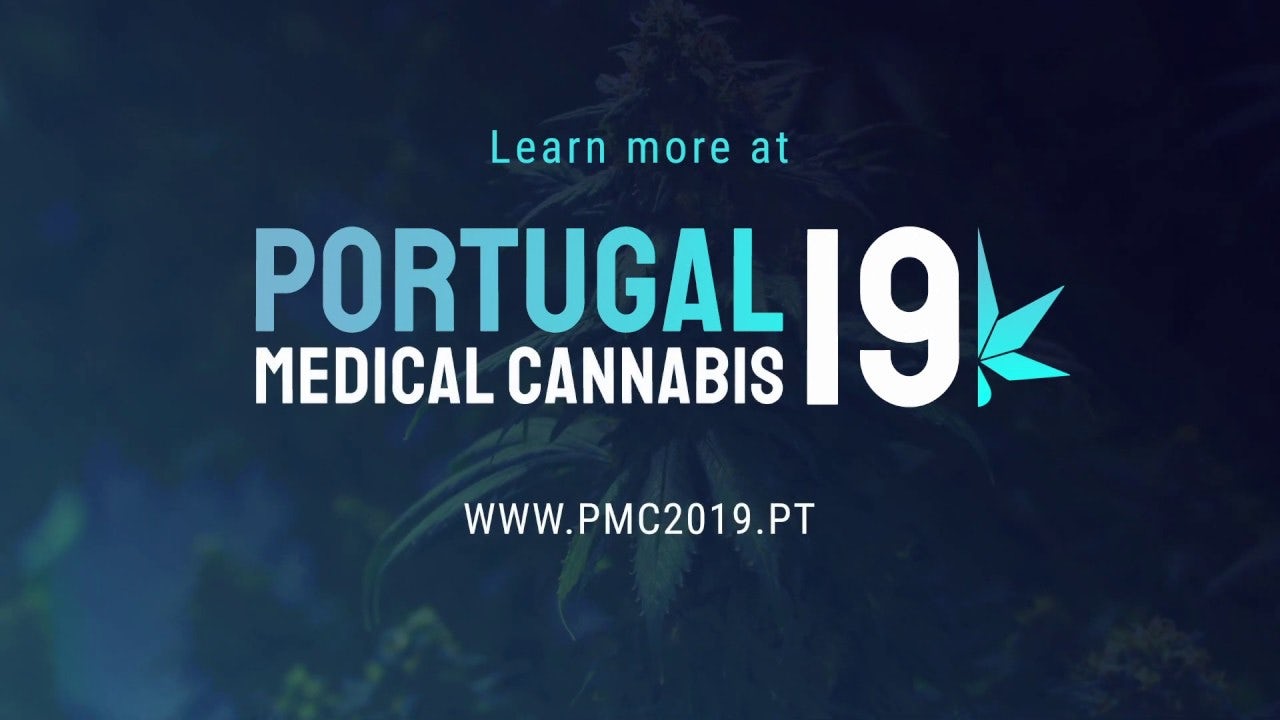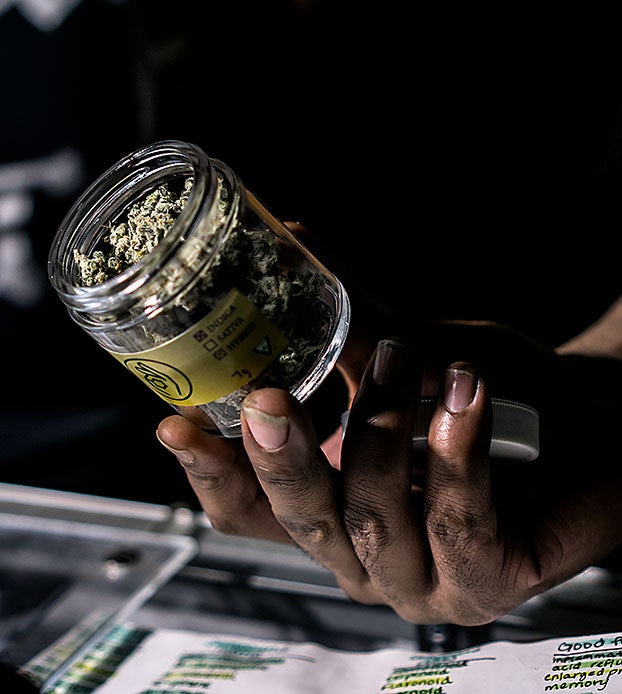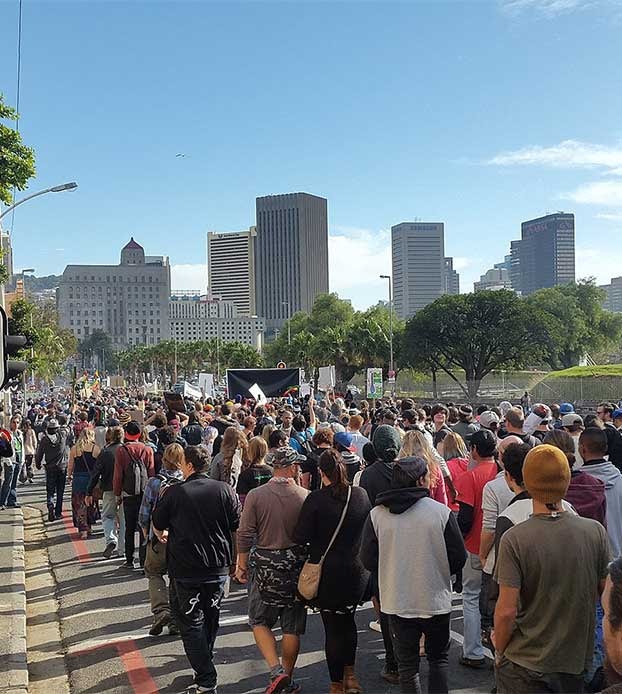In the United States, President-Elect Joe Biden and Vice President-Elect Kamala Harris have committed to decriminalizing cannabis. The UN also just voted to remove cannabis from a list of narcotic drugs following a suggestion from the World Health Organization.
But 2020 has also been a pivotal time for the psychedelic movement as well. The state of Oregon, for instance, recently passed measures 109 and 110, effectively legalizing psilocybin therapy and decriminalizing “hard” drugs.
These advancements in cannabis and psychedelic legalization have profound implications for many groups, especially for those suffering from mental health disorders or addiction. However, it also begs a crucial question: how does cannabis interact with other psychedelics like LSD or psilocybin?
The answer, unfortunately, isn’t clear cut. In fact, we couldn’t find a single research paper that covered cannabis and psychedelic drug interactions — so instead we’ve reviewed relevant research and summarized it here.
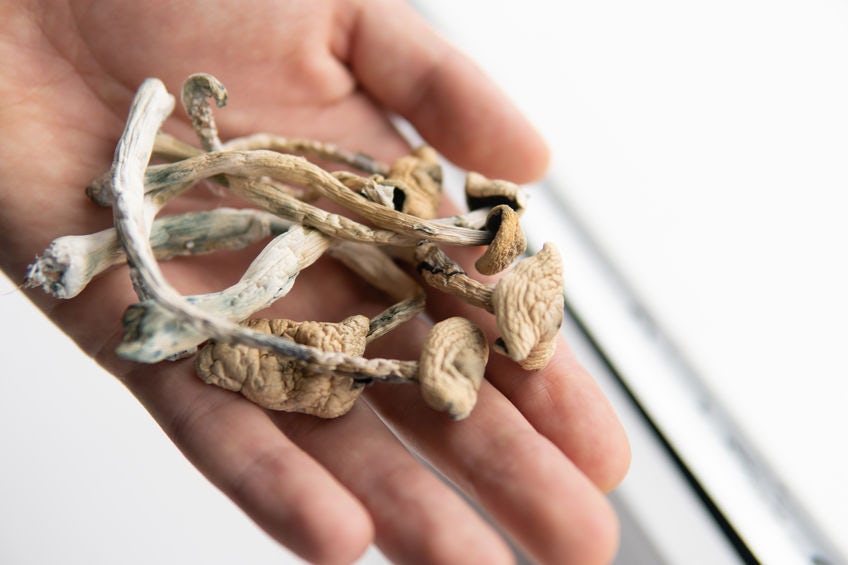
What is a psychedelic/hallucinogen?
The term psychedelic is derived from the Greek words ‘ψυχή (psyche, or mind), and ‘δηλείν’ (delein, to reveal). Hallucinogen is sometimes used in lieu of psychedelic. Today these terms are used to denote a class of drugs known for their mind-altering abilities.
There are a number of different types of drugs that fall within the psychedelic category. And while all of these drugs can produce profound changes in consciousness, they all have their own unique mechanism of action.
Classic psychedelics/hallucinogens act on 5-HT2A serotonergic receptors. These include Lysergic acid diethylamide (LSD), psilocybin, mescaline, N,N-dimethyltryptamine (DMT). The effects of these drugs are often characterized as psychotomimetic, aka mimicking psychotic or schizophrenia-like states.
Entheogens (also known as Entactogens) are another type of drug which can be classified as a psychedelic. The term is derived from the Greek terms ‘ἔνθεος’ (entheos; to be inspired or filled with God), and ‘γενέσθαι’ (genesthai, to come into being). These types of compounds are known for producing deep feelings of love, connection, and empathy in ritual or religious contexts. This includes ayahuasca, peyote cactus, hallucinogenic mushrooms, and Salvia Divinorum. MDMA (3,4-methylenedioxymethamphetamine) also falls under this category.
Another type of drug which is sometimes classified as a psychedelic is NMDA antagonists, also known as dissociative agents. Ketamine is one type of drug that falls into this category.
Is cannabis a psychedelic?
Cannabis has been used extensively in spiritual contexts for thousands of years.
In India, spiritual cannabis use may even go back to prehistoric times. Research has found evidence of cannabis use in Judahite worship going back as far as the eighth century BCE. And in Jamaica, the tradition of smoking ganja in a chillum pipe is sometimes viewed as a sacramental act.
A study published in this year’s Journal of Cannabis Research interviewed 319 participants on their cannabis and psychedelic drug use. They found two primary types of cannabis use: recreational and spiritually motivated. One-quarter of those surveyed considered cannabis to be an entheogen, with researchers noting that:
“These spiritual cannabis users…reported cannabis experiences that in some aspects resembled experiences with psychedelics…
Interviewees described entheogenic experiences as being characterized by insight into self, relations, and world, inner visions, feelings of peace, joy, and love, and occasional peak experiences involving ego dissolution and what was interpreted as contact with transcendent forces.”
Like traditional hallucinogens, chronic cannabis use can alter 5-HT2A receptor activity. Cannabis can also produce psychotomimetic state effects similar to that of ketamine, furthering the evidence that cannabis can have psychedelic-like effects.
It is important to note that chronic cannabis use, especially Type I cannabis, and psychedelic use may be associated with an increased risk of schizophrenia and psychosis. Though, much of this data suggests that this correlation may be related to a genetic predisposition for schizophrenia.
The importance of understanding drug interactions
Drug interactions can occur when two compounds are taken concurrently. The nature of these interactions is dictated by several factors including the patient’s condition and nature of the drugs ingested.
There are three primary effects of drug interactions:
- Additive (1 + 1 = 2)
- Synergistic (1 + 1 > 2)
- Antagonistic (1 + 1 < 2)
One meta-analysis performed in 2012 found that in 7% of cases serious drug interactions were the cause of hospital admission. Understanding potential drug interactions, then, is vital to minimizing risks associated with drug therapy and is a good way to prevent or anticipate any adverse effects which may occur.
The importance of set and setting
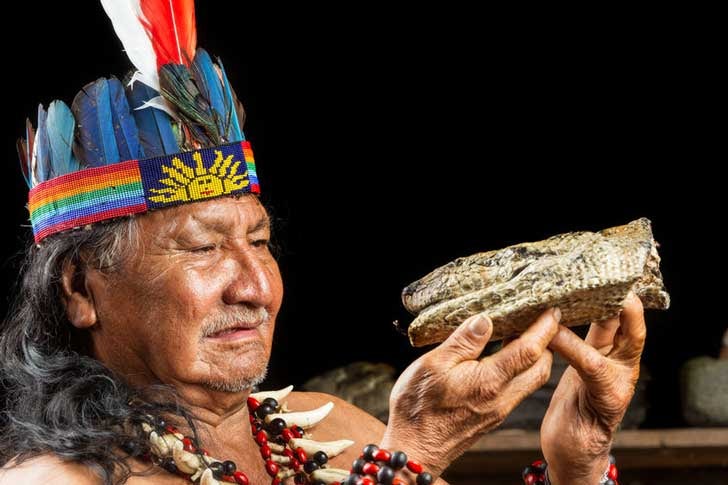
In order to understand how cannabis interacts with other psychedelics, we’ll need to first broach the subject of set and setting.
American scientists in the 1950s and 1960s set out to determine how LSD affected users. Try as they might, they couldn’t quite ascertain “standard effects,” i.e. how a drug should or typically behaves.
Researchers eventually determined that “the pharmacology of psychedelics was not solely responsible for determining their subjective effects,” adding,
“The expectations and personal experiences of the individual taking them as well as the external environment were recognized as vitally important in influencing users’ experiences. These factors were respectively dubbed set and setting, and are now well-established elements of human hallucinogen research. (Johnson et al., 2008; Fadiman, 2011; Leary et al., 1963).
Set and setting, or short for mindset and setting, were provided as an explanation as to why some people responded positively to psychedelics while others did not. Set and setting are thought to influence whether you have a “good” or “bad” trip. The type of psychedelic experience you’ll have is a huge determinant in assessing how cannabis will interact with any given psychedelic.
Cannabis and LSD drug interactions
The belief that cannabis is a weaker form of LSD isn’t a new one. In fact, Dr. Harris Isbell, a former CIA employee, released a report in 1969 that concluded high doses of THC could create hallucinations similar to LSD.
Dr. Isbell’s findings have been corroborated by recent advances in cannabinoid research. A 2013 research paper found that cannabinoid receptor agonists, or agents that activate receptors to produce a response, upregulated the 5-HT2A serotonergic receptors in rats. Upregulation is the process by which cells increase their biological responses to stimuli.
The 5-HT2A serotonin receptor is responsible for a variety of functions and is the primary receptor involved with most classic psychedelics. Dysregulation at this receptor site is also linked to a variety of conditions such as psychiatric disorders (anxiety, depression, schizophrenia) as well as other conditions like headaches and hallucinations.
Another paper published in 2018 found that chronic exposure to THC “induced a pro-hallucinogenic molecular conformation” of the 5-HT2AR receptor in mice which “exacerbated schizophrenia-like responses.”
LSD is a powerful 5-HT2A agonist, so much so that it has a stronger binding affinity for the receptor than serotonin itself. LSD is also strongly attracted to other 5-HT receptors, which further complicates predicting its pharmacologic effects.
These findings suggest that concurrent administration of cannabis and LSD may have an additive or synergistic effect, particularly when it comes to visual hallucinations. However, this effect is ultimately subjective. Whether or not you’re having a good or bad experience is more determined by factors such as dose, set, and setting.
Conventional wisdom says if you’re having a “good trip” then cannabis may enhance the experience, and vice versa — with a “bad trip” cannabis may contribute negatively to it. Another important factor that is generally unstudied would be what cannabis chemovar is being consumed.
Cannabidiol (CBD) is currently being evaluated for its antipsychotic effects. Taking CBD with other psychedelics, then, may reduce their psychomimetic effects, but this relationship remains unclear.
Like cannabis, LSD is reasonably safe at psychoactive doses and has low abuse potential compared to many other substances. There have been no known deaths due to LSD overdose.
Cannabis and psilocybin interactions
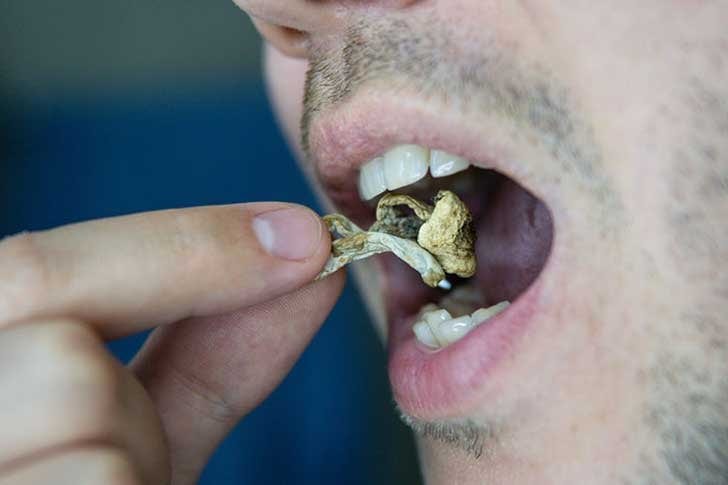
Psilocybin is the primary compound found in “magic mushrooms.” Upon consumption, psilocybin is converted to its more active form, psilocin.
Like LSD, psilocybin and psilocin are classic hallucinogens that act as agonists at the 5-HT2A site. Interestingly, like cannabis, there are anecdotal reports of different strains of mushrooms having differing effects.
Cannabis can have a profoundly distinct impact when taken concurrently with psilocybin. In 2019 the pro-psychedelic publication Double Blind surveyed 90 people who reported combining cannabis and psychedelics. The publication also interviewed medical experts who could speak to the effects of combining cannabis and psychedelics.
Dr. Nikola Djordjevic, Medical Advisor at Loud Cloud Health, confirmed in the piece that, “…many peoples’ senses are enhanced when they combine cannabis with psilocybin”:
“This may manifest itself in the person experiencing more intense audio and visual hallucinations…The strong visuals produced by using cannabis and psilocybin together may be exciting for some and terrifying for others.”
One primary difference between LSD and psilocybin is a subjectively reported experience: introspection. Psychedelic users frequently report having deeper feelings of introspection, or inward-facing journeys on mushrooms. This may help explain why mixing cannabis and psilocybin may result in more adverse reactions (particularly with regard to mental agitation and anxiety) compared with LSD.
Cannabis and DMT/ayahuasca interactions
N, N-Dimethyltryptamine, or DMT, is an endogenous hallucinogen, meaning it’s produced in the body. It’s produced in the pineal gland and is thought to be responsible for experiencing dream states.
Ayahuasca is a hallucinogenic, entheogenic brewed from various plants native to South America. The plants commonly used to make ayahuasca contain both DMT and MAO-inhibiting harmala alkaloids, which prevent the body from breaking down the DMT and extend the psychedelic experience.
While DMT has been shown to interact with a number of receptors exogenously administered, DMT acts on the 5-HT2A receptor. As such, it’s possible that combining THC with DMT could have an additive or synergistic effect while using CBD may confer an antipsychotic effect.
Cannabis and mescaline interactions (San Pedro/Peyote)
Mescaline is an entheogenic, classic hallucinogen found in the San Pedro and Peyote cacti. It also demonstrates a high affinity as a partial agonist at the 5-HT2A receptor site.
In terms of effect, mescaline can closely resemble LSD but requires a higher dose to produce those effects. Doses of 300-500 mg can produce, “…olfactory or auditory hallucinations, illusions, depersonalization, and anxiety depressive symptoms.” Physical effects can often include sweating, nausea, vomiting, and tremor. Despite these unwanted side effects, mescaline containing cacti are generally considered more gentle and introspective than some other psychedelics, which may be in part due to the partial agonism at 5-HT2A. This is the same concept that underpins the effects of whole-plant cannabis versus that of synthetic cannabinoids.
There isn’t much research available concerning drug interactions between cannabis and mescaline. It’s possible that combining cannabis and mescaline can also have an additive or synergistic effect. However, this experience, like LSD, is subjective. This means the synergistic effect will make a trip more pleasant or more unpleasant depending on set/setting and an individual’s unique responses to cannabis. Cannabis, particularly CBD, may also help reduce some of the nausea and tremors associated with mescaline use due to its anti-emetic properties via 5-HT1A.
Cannabis and ketamine interactions
Ketamine is a unique substance. It’s technically classified as an anesthetic, or compound used to help treat pain. It is commonly used in hospital emergency departments and operating rooms to produce profound sedation.
Ketamine acts primarily on the NDMA receptor rather than the 5-HT2A receptor-like classical hallucinogens. It’s categorized as a psychedelic due to its ability to act as a dissociative agent, produce psychomimetic and psychedelic effects in a dose-dependent manner.
Unlike the rest of the substances listed here, researchers have noted that “…the safety profile of ketamine appears to be altered when used in a polydrug manner.”
A 2012 research paper published in the Journal of Clinical Anaesthesia found that combining ketamine and cannabis resulted in a further reduction of pain. This led researchers to suggest that ketamine and cannabis may act synergistically at one or more receptors.
There is a clear overlap of pharmacology between cannabis and psychedelics. Both are being considered as novel treatments for conditions that currently lack adequate effective therapies like anxiety, depression, and PTSD. As the world enters a new era or drug policy, we can expect to see these two classes of drugs — cannabinoids and psychedelics — being brought up frequently.
Sign up for bi-weekly updates, packed full of cannabis education, recipes, and tips. Your inbox will love it.

 Shop
Shop Support
Support

